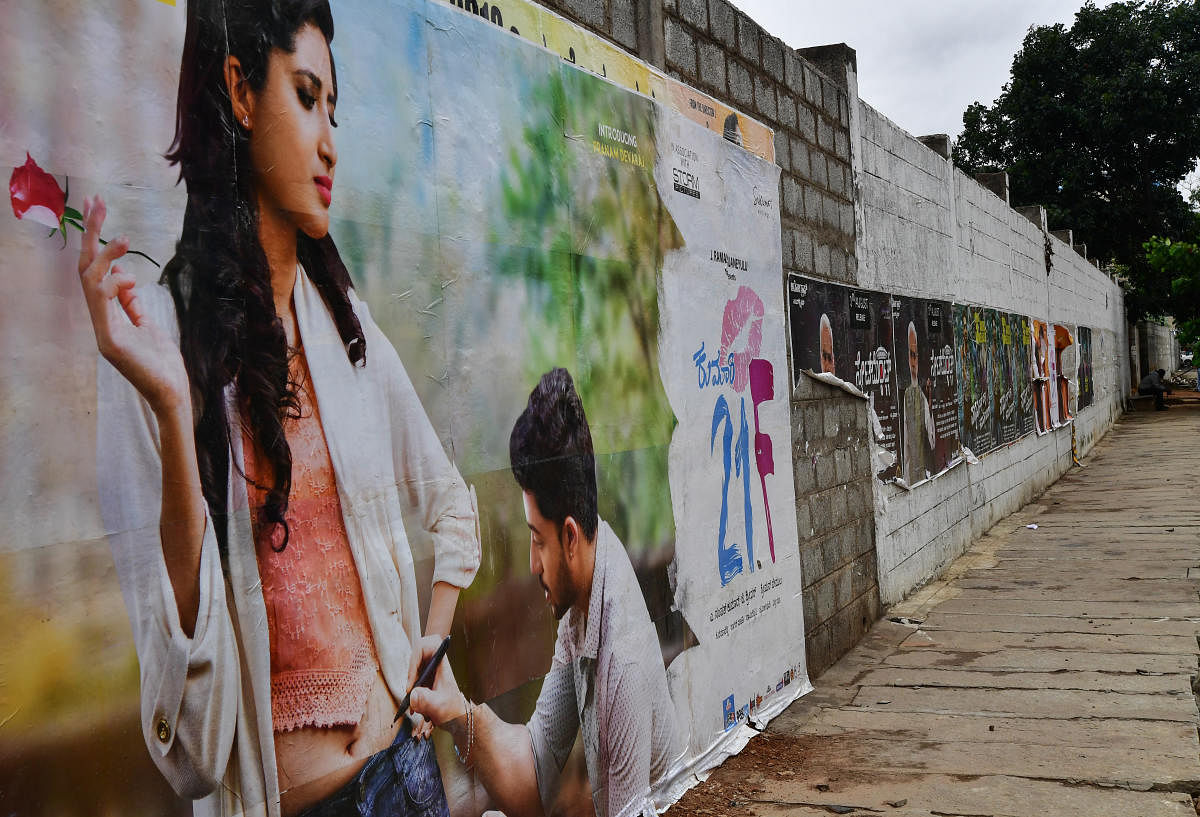
In the absence of permission to stick posters and display hoardings, movie producers are banking on social media to promote their releases in Bengaluru.
It has been a year since the BBMP banned hoardings and posters, citing city aesthetics and scams in licensing. They are allowed inside movie halls, though.
The ban has dealt a blow to traditional movie promotions: movie buffs can no longer see posters on the walls of public buildings, or hoardings advertising new releases.
The BBMP is talking about bringing back hoardings in a regulated and restricted manner, but filmmakers have discovered other ways of publicising their productions. YouTube, Twitter, Facebook and Instagram are now used routinely to promote films.
Social media publicity is way cheaper than conventional publicity, industry insiders say.
Actor and director Ramesh Aravind believes the most effective way to reach movie buffs is the mobile phone, since almost everyone carries one. “Posters, hoardings and cut-outs were a craze at one point. You would see 100 days of a film being celebrated but the business model has changed now. I would be surprised to see 100th-day posters now,” says Ramesh.
But, he says, social media is not foolproof: it is difficult to tell real likes from fake ones on sites such as Facebook. “You don’t know what is working. Quantifying social media is a challenge. The chances of misinterpretation of data are high,” says Ramesh, an engineer before he switched to acting. Stars shouldn’t be overwhelmed by the numbers because they may be inflated, he warns.
“I am more interested in the organic reach. Nothing works like real content. When you see a video that is genuinely good and it has likes, it is fine, but when an undeserving video gets soaring numbers, you doubt the authenticity,” reasons Ramesh.
Actor Gururaj Jaggesh, whose film ‘Vishnu Circle’ has just hit screens, applauds the government’s efforts to curb hoardings and posters. “They generate huge amounts of pollution and waste. Even the glue used to stick posters has an adverse effect on the environment. Social media has a strong reach and gives room for a lot of creativity,” says Gururaj.
His publicity team used LEDs screens, Facebook, Twitter and short videos to promote the film.
Director Nagathihalli Chandrashekhar feels hoardings and posters must be allowed in designated places. “There should be a disciplined way of putting up these hoardings. Licences must be in place and it should all be corruption-free,” he says.
His latest directorial, ‘India vs England,’ is being promoted through short videos and digital posters on social media. “I still see film posters near schools, hospitals, and on electrical poles in the interiors of the city. Filmmakers should promote their films in a responsible manner,” he says.
Actor Vasishta N Simha says posters definitely made a big impact on movie buffs at one time but now social media is the way to go.
“We sometimes stick posters behind autos and buses. This is a good way of mobile advertising. But on social media, people are up to date about a film. Strategising publicity on social media is key to a successful launch,” says Vasishta.
Kannika Urs, promotional consultant for ‘Mundina Nildana’, ‘Naduve Antharavirali’, ‘Paddehuli’ and other recent films, says almost all publicity is digital these days. “Audiences today are so up to date with technology, they use it like word of mouth to talk about films. We are not missing hoardings,” she says.
Many filmmakers request celebrities to give a shout-out for their films.
“In today’s traffic who has the time to look at the hoardings? And how do we know how many people saw it?” says Kannika.
She recommends standees at multiplexes and Metro stations, where footfalls can be counted. The three greatest benefits of film promotions on social media reach, cost-effectiveness, and quantifiability, she says.
How much it costs
For Facebook video promotions if Rs 1 lakh is boosted then between 7 lakh to 1million views can be earned. YouTube certified TruViews charge between 30 p to 40p per view and unfortunately Kannada and Malayalam languages aren’t currently approved so a few movie teams get fake views done and after few days the view count gets dropped. The digital promotions producer usually keeps a budget of Rs 3 lakh to 10 lakh for campaign on digital platforms.
New policy soon
BBMP Commissioner B H Anil Kumar says a comprehensive new policy on outdoor advertising is on the cards. “A committee is looking into the objections,” he told Metrolife. He expects the process to be done in 15 days. “Hoardings must be regulated. That’s why we are bringing in rules. The BBMP has already classified zones as regards hoardings. We will take a relook and adopt all necessary measures,” he says.